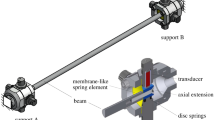Abstract
In many engineering problems, the response function such as the strain or stress field of the structure, its load-bearing capacity, deflection, etc., comes from a finite element method discretization and is therefore very expensive to evaluate. For this reason, methods that replace the original computationally expensive (high-fidelity) model with a simpler (low-fidelity) model that is fast to evaluate are desirable. This paper is focused on the comparison of two surrogate modeling techniques and their potential for stochastic analysis of engineering structures; polynomial chaos expansion and artificial neural network are compared in two typical engineering applications. The first example represents a typical engineering problem with a known analytical solution, the maximum deflection of a fixed beam loaded with a single force. The second example represents a real-world implicitly defined and computationally demanding engineering problem, an existing bridge made of post-tensioned concrete girders.
Access this chapter
Tax calculation will be finalised at checkout
Purchases are for personal use only
Similar content being viewed by others
References
Borgonovo, E., Plischke, E.: Sensitivity analysis: a review of recent advances. Eur. J. Oper. Res. 248, 869–887 (2016)
Blatman, G., Sudret, B.: An adaptive algorithm to build up sparse polynomial chaos expansions for stochastic finite element analysis. Probab. Eng. Mech. 25(2), 183–197 (2010)
Blatman, G., Sudret, B.: Adaptive sparse polynomial chaos expansion based on least angle regression. J. Comput. Phys. 230(6), 2345–2367 (2011)
Bourinet, J., Deheeger, F., Lemaire, M.: Assessing small failure probabilities by combined subset simulation and support vector machines. Struct. Saf. 33(6), 343–353 (2011)
Červenka, J., Papanikolaou, V.K.: Three dimensional combined fracture-plastic material model for concrete. Int. J. Plast. 24(12), 2192–2220 (2008)
Echard, B., Gayton, N., Lemaire, M., Relun, N.: A combined importance sampling and kriging reliability method for small failure probabilities with time-demanding numerical models. Reliab. Eng. Syst. Saf. 111, 232–240 (2013)
EN 1992-1-1. Eurocode 2: Design of concrete structures – Part 1-1: General rules and rules for buildings, National Annex A. Prague, Czech Republic (2021)
Ghanem, R.G., Spanos, P.D.: Stochastic Finite Elements: a Spectral Approach. Springer, Berlin, Heidelberg (1991). https://doi.org/10.1007/978-1-4612-3094-6
Hurtado, J.E.: An examination of methods for approximating implicit limit state functions from the viewpoint of statistical learning theory. Struct. Saf. 26(3), 271–293 (2004)
Iman, R.L., Conover, W.J.: Small sample sensitivity analysis techniques for computer models with an application to risk assessment. Commun. Stat. Theory Methods 9(17), 1749–1842 (1980)
JCSS Probabilistic Model Code. Joint Committee on Structural Safety (2001). www.jcss-lc.org/jcss-probabilistic-model-code/
Kleijnen, J.P.C.: Sensitivity analysis of simulation models: an overview. Procedia Soc. Behav. Sci. 2, 7585–7586 (2010)
Koehler, J.R., Owen, A.B.: Computer experiments. Handb. Stat. 13, 261–308 (1996)
Kubat, M.: An Introduction to Machine Learning. Springer International Publishing, Switzerland, Cham (2015). https://doi.org/10.1007/978-3-319-20010-1
Lehký, D., Šomodíková, M.: Reliability calculation of time-consuming problems using a small-sample artificial neural network-based response surface method. Neural Comput. Appl. 28, 1249–1263 (2017)
Lehký, D., Slowik, O., Novák, D.: Reliability-based design: artificial neural networks and double-loop reliability-based optimization approaches. Adv. Eng. Softw. 117, 123–135 (2018)
Lehký, D., Šomodíková, M., Lipowczan, M.: An application of the inverse response surface method for the reliability-based design of structures. Neural Computing and Applications (2022). in print
McKay, M.D., Conover, W.J., Beckman, R.J.: A comparison of three methods for selecting values of input variables in the analysis of output from a computer code. Technometrics 21, 239–245 (1979)
Novák, D., Teplý, B., Shiraishi, N.: Sensitivity analysis of structures: a review. In: International Conference CIVIL COMP 1993, pp. 201–207. Edinburgh, Scotland (1993)
Novák, D., Vořechovský, M., Teplý, B.: FReET: software for the statistical and reliability analysis of engineering problems and FReET-D: degradation module. Adv. Eng. Softw. 72, 179–192 (2014)
Novák, L.: On distribution-based global sensitivity analysis by polynomial chaos expansion. Comput. Struct. 267, 106808 (2022)
Novák, L., Novák, D.: Polynomial chaos expansion for surrogate modelling: theory and software. Beton-und Stahlbetonbau 113, 27–32 (2018)
Novák, L., Vořechovský, M., Sadílek, V., Shields, M.D.: Variance-based adaptive sequential sampling for polynomial chaos expansion. Comput. Methods Appl. Mech. Eng. 386, 114105 (2021)
Pan, L., Novák, L., Lehký, D., Novák, D., Cao, M.: Neural network ensemble-based sensitivity analysis in structural engineering: Comparison of selected methods and the influence of statistical correlation. Comput. Struct. 242, 106376 (2021)
Slowik, O., Lehký, D., Novák, D.: Reliability-based optimization of a prestressed concrete roof girder using a surrogate model and the double-loop approach. Struct. Concr. 22, 2184–2201 (2021)
Sobol, I.: Global sensitivity indices for nonlinear mathematical models and their Monte Carlo estimates. Math. Comput. Simul. 55, 271–280 (2001)
Soize, C., Ghanem, R.: Physical systems with random uncertainties: chaos representations with arbitrary probability measure. J. Sci. Comput. 26, 395–410 (2004)
Stein, M.: Large sample properties of simulations using Latin hypercube sampling. Technimetrics 29(2), 143–151 (1987)
Sudret, B.: Global sensitivity analysis using polynomial chaos expansions. Reliab. Eng. Syst. Saf. 93(7), 964–979 (2008)
Efron, B., Hastie, T., Johnstone, I., Tibshirani, R.: Least angle regression. Ann. Stat. 32(2), 407–499 (2004)
Vořechovský, M.: Correlation control in small sample Monte Carlo type simulations II: analysis of estimation formulas, random correlation and perfect uncorrelatedness. Probab. Eng. Mech. 29, 105–120 (2012)
Xiu, D., Karniadakis, E.G.: The Wiener-Askey polynomial chaos for stochastic differential equations. SIAM J. Sci. Comput. 24(2), 619–644 (2002)
Acknowledgement
This work was supported by the project No. 22-00774S, awarded by the Czech Science Foundation (GACR).
Author information
Authors and Affiliations
Editor information
Editors and Affiliations
Rights and permissions
Copyright information
© 2023 The Author(s), under exclusive license to Springer Nature Switzerland AG
About this paper
Cite this paper
Lehký, D., Novák, L., Novák, D. (2023). Surrogate Modeling for Stochastic Assessment of Engineering Structures. In: Nicosia, G., et al. Machine Learning, Optimization, and Data Science. LOD 2022. Lecture Notes in Computer Science, vol 13811. Springer, Cham. https://doi.org/10.1007/978-3-031-25891-6_29
Download citation
DOI: https://doi.org/10.1007/978-3-031-25891-6_29
Published:
Publisher Name: Springer, Cham
Print ISBN: 978-3-031-25890-9
Online ISBN: 978-3-031-25891-6
eBook Packages: Computer ScienceComputer Science (R0)




